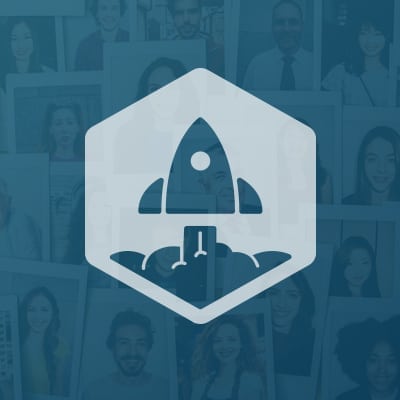As we gear up for SaaStr Europa 2024 in London on 4-5 June and SaaStr Annual 2024 in the SF Bay Area on September 10-12, we wanted to take a look back at some of our most iconic speakers and sessions from over the year, that we can still learn from today.
Today, Zoom is at $4B ARR. In many ways, it’s the same Zoom, albeit with a much more enterprise focus. But at $100m ARR, Zoom was still a scrappy upstart. And importantly, it was burning just about $0. Yes, Zoom’s net burn was $0 in the run-up to the IPO. $0. More on how they did it here.
Eric Yuan, founder and CEO of Zoom Video Communications shared at SaaStr Annual 2017 how he and his team got to the first $100m ARR as well as his philosophy on running a company:
- How to grow sustainably
- Hiring overqualified people — or not
- How to find the right investors
- Freemium, when it works
- Billboards, why to do them
- How attending SaaStr Annual is the “Superbowl Moment” for SaaS execs!
- And so much more!!
Announcer: Want to know who has sold over a billion dollars in subscription products? There aren’t too many, and we’ve got perhaps the only one. Welcome back second-time SaaStr annual speaker, and executive vice president of RPX Corporation, Mallun Yen.
Mallun Yen: Eric, I am so happy to be here with you today.
Eric Yuan: Thank you.
Mallun: Many of you may have noticed that the title to this talk used to be Building a Super Efficient Prenicorn, Get Sixty Spend Six. Due to some events of a couple weeks ago, we had to change the title. We were going to change it, briefly, to Building a Super Efficient Unicorn but Eric is so humble and so modest, he said, “We can’t use the U word.”
So, [laughs] we’ve changed it again. Getting to $100 ARR While Burning Almost Nothing, is pretty good I think. Congratulations on your recent raise, Eric, and your phenomenal growth.
Eric: Thank you.
Mallun: Now I think the hard part starts, right? You started Zoom six years ago?
Eric: Five and a half.
Mallun: Five and a half years ago. Take us back. What was it like leaving WebEx and deciding, “OK. I’m going to start another video company”?
Eric: It’s not an easy decision. It was very emotional. I was one of the first of several founding engineers. Ultimately, I became Vice President of Engineering at WebEx. I was there for so many years, and sort of, the product is your baby. Also, we build our products and have so many team members there.
Every time I thought about, “I’m going to be leaving…” It’s really hard. It’s very emotional. But finally, I made it.
Mallun: So then, you leave and you decide, “OK. I’ll just start a company?”
Eric: Before I left, I did spend a lot of time talking with all kinds of customers. The market we are playing is a video conferencing market. It’s sort of very crowded. My friend told me that, “It’s too crowded, you cannot build a sustainable solution.”
But guess what? After I talked with all the customers, not all of the customers they feel happy. All the solutions they’re using, they do not feel comfortable. That’s why I saw there’s an opportunity for me to build a much better solution.
Mallun: Take us back to the early days. You have this idea. You know that the customers aren’t happy. You know “OK, I think I can do this better. I know something about video.” Did you start developing the product first or go raise money first?
Eric: For sure we raised the money first. This is the tough part, to raise money. Probably, that’s one to the key lessons I learned. We live in Silicon Valley and we have an advantage to have access to many good VCs and also good investors. To find the right investor and a VC is really not easy.
Many VCs there, always tell you they are better. However, I think our philosophy is to find the investor who will like to invest in me, not just in our business. The business can be up and down. Your original founding ideas might end up being wrong for the market, which could be too painful for the business.
If that happens and if your investors, they invest not in you, in your business, guess what? There’s a conflict down the road. Very likely, we see they might be bringing the a new CEO that’s going to replace you.
However, to find an investor who are going to invest in you, not in your business, is very tricky. Almost every one of them will tell you they are interested in investing in you. You’ve got to test them. In my case, I did a lot of tests. That’s why I found an investor who truly bet on me, invested in me.
My analogy is more like, when you were young you thought about who to marry. For sure you wanted to marry the one who really liked you or loved you. You do not want to date the one who always asks about how much money you have, how healthy you are, what’s your family background? I think that’s not sustainable.
Ultimately, I found an investor who really liked to invest in me.
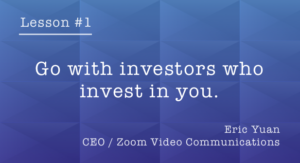 Mallun: That’s learning number one, “Go with the investors who invest in you, (or someone you might want to be married to)?”
Mallun: That’s learning number one, “Go with the investors who invest in you, (or someone you might want to be married to)?”
Eric: Yeah.
Mallun: Got it. After your seed round, you raised 6 million in an A, 6 and a half in a B, 30 in a C, and now 100 million. When you took the 30 million in your C, which was led by Emergence, you had all of the previous round in the bank. Now that you’ve raised the 100 million from Sequoia, you have all of the 30 million in the bank.
Tell us a little bit about this philosophy. Why raise if you have all of the money, previously, still in the bank?
Eric: In our case, for any new initiatives, we always would like to test the water first. Then we double down or triple down on that. Quite often, it will take some time to test the water. After you finish testing the water, you try to double down on something. If you do not have a budget, and at that time you thought about raising a round, it probably takes some time.
The opportunity window might be gone. That’s why we always thought about if we should have enough budget in case there’s huge opportunities down the road, we can double down on that. Ideally, you really focus on the customer experience, make sure your customer happy.
If you do that, the VCs, they are going to know you. They probably are going to stop by to ask about if you need money or not. In that case, even if you do not need money, you better take it. In the future, you have more opportunities down the road, make sure you have the capital ready.
Mallun: Do you ever get pressure from your investors who have put in, say, the 6 and a half, and then the 30, and now the 100 to say, “Eric, we gave you the money, not to have it sit in your bank account”?
Eric: I think I mentioned being married with them. I do not think that they’re going to give us pressure. For sure, we want to spend in a smart way.
We cannot burn all the money. We always thought about how to spend more but burn less. Everybody would think about, “If we invest this amount this quarter, can we be in a cash flow positive or reach profitability next quarter or next month or not?” Every time, every month, we test it.
Mallun: That’s worked well for you until this stage. Do you think that will work for you for this next stage going forward, and could your growth have been even higher if you had actually spent more?
Eric: I think, ultimately, we do not want to grow too fast. Our philosophy is we really focus on making our existing customer happy. We do not aggressively pursue the new prospect. Also, we always prioritize the features requested by our existing customers over the new prospect.
We truly believe if you do not make the existing customer happy, even if you get more new prospect, it may not be sustainable. That’s why I always share with my team, it’s more like I drive here from San Jose to San Francisco. If I drive 80 miles in one hour, then I might get here in one hour.
Let’s say it’s like 65 miles per hour. Just to save 15 minutes, but the risk is very high. It may not be manageable. You might get a ticket if you drive too fast, your car might crash because of the road conditions.
We really want to focus on sustainable growth, focus on existing customers, rather than aggressively targeting the new prospects.
Mallun: The learning number two. To summarize what you said a moment ago was basically, “Don’t wait until you need it to raise,” right?
Eric: That’s right.
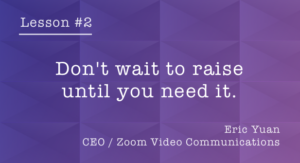 Mallun: In fact, you were fortunate enough that you actually weren’t even looking to raise when you were approached by some of these investors?
Mallun: In fact, you were fortunate enough that you actually weren’t even looking to raise when you were approached by some of these investors?
Eric: Yeah. By the way, also, many people told me that. If you need to raise money, you may not get it. However, if you do not need the money, it’s very likely you’ll get it. I have no idea why this is the case, but I can tell you that’s absolutely right.
Mallun: [laughs] Let’s talk a little bit about the, “Spend more, burn less,” and how are you able to go to 100 million ARR while spending very little. You went from 0 to 100 million in five and a half years. Tell us a little bit about how the first revenue came. Tell us about your first six figure deal, your first sales.
Eric: Maybe let me share with you a little bit about the first deal and then I can share with you the first big deal. The first deal is…I really appreciate Stanford. Stanford Continuing Studies Group is our first customer, even before our solution ready. They give us huge confidence.
At that time, no sales team, no marketing team, just the engineers. We sold our solution and give us a greater confidence. In terms of the six figure deal, I think that’s the first one I think also the important one. Sorry, I don’t want to mention the company name. That company got a new CIO. The new CIO came from Microsoft.
That time, we spent a lot of time, I’m pretty sure they are going to standardize on Microsoft’s solution. However, he did not do that. His IT team is very smart. They tested 42 solutions all together. I probably wouldn’t know a dozen solution.
Mallun: I was going to say, I didn’t know there were 42 solutions.
Eric: I do not know. They tested 42 solutions. Finally, they pick up three. They also did not make a final decision. They pick up the employees across multiple departments and they chose 100 employees, give them 90 days to test a solution. Finally, 99 out of 100 employees, they selected Zoom and we got that big deal.
Mallun: This is your first six figure deal, this is not the continuing education?
Eric: Six figure deal. That’s the big deal.
Mallun: Were you worried [laughs] during that 90 day period?
Eric: For sure. Yeah. We thought were going to lose that deal. I was very nervous at that time. Anyway, we got to give the credibility to that company’s CIO.
Mallun: Zero to hundred million in five and a half years, what revenue bucket do you think was the hardest?
Eric: I think to get the first one million MRR is very difficult because nobody knows you. Also, at that time, we only had an engineering team. We do not have marketing team. We did it on purpose. Before we reach one million, we do not want to create a marketing team. Only sales team.
Most of our leads are organic leads. We do not want to spend money to generate leads. I think the first one million MRR is very, very hard. It’s just a sales team, just to sell.
Mallun: Did you have a VP of Sales, or a Head of Sales, on board during that time?
Eric: Yes. After our founding team we closed several deals, we hired a VP of Sales and he hired a bunch of the sales guys. So, yes.
Mallun: Let’s look at this for a second. Those of you who live in the Bay Area have probably seen these billboards. Where did you first get this idea for a billboard?
Eric: When I came to the Valley in 1997, somehow I fell in love to the billboard. At that time I was thinking, “Some day when I start a business, I will have a billboard.”
[laughter]
Mallun: It loves you back, apparently. Describe your approach to billboards. This was the single billboard in 2015. Then, fast forward two years later we have, not only billboards…I think we cut off the picture of Steph Curry in there, but he’s in there as well, and we’ve got the Warriors, you’ve got the airports…
Tell us about your philosophy behind this approach. We know that you’re very frugal. You can’t just be sponsoring the Warriors for the heck of it.
Eric: When it comes to spending, we always test the water and then we decide, “Are we going to double down or not?” For the billboard, any marketing initiatives, that’s also the same. In terms of billboard, actually, we do not know. Even today, I still do not know if it works or not.
It’s more like on a brand, it’s to promote our brand. It’s hard to market a brand within a short period of time. After we had our first billboard, my neighbor, she told me that, “I saw your billboard.” I think, wow, this is great.” Then I told our marketing team, “Let’s have another one.” Soon, a lot of other people they say, “We saw your billboard.” OK, “Let’s add a third one.”
We keep adding more and more. Probably, we have four or five billboards now.
Mallun: I meant to buy stock in all the companies that sell the banners in the airports before I asked you this question on stage, but I didn’t. I’m going to ask it anyway. Which is, then you started showing up in all the airports as well. From there, did you know what would happen when you started being in the airports?
Eric: I think, first of all, in terms of brand awareness, it certainly helped us a lot. A lot of business knowledge workers, whenever they travel, they saw our billboard. However even today, I think most of our leads are still coming from organic growth. Not from those billboards from any airport either.
Mallun: Marketing is hard to get right. We all know that. How do you see this approach fitting in with the marketing because it’s organic growth? How much of this results in lead gen?
 Eric: It’s not that much at all. Again, our lead generation I think primarily coming from our organic leads. Our existing happy customers refer to other customers. A lot of freemium product also gives a lot of qualifying leads. Again, this is just the brand awareness. Maybe in next two to three years, looking back, we will know if this is effective or not.
Eric: It’s not that much at all. Again, our lead generation I think primarily coming from our organic leads. Our existing happy customers refer to other customers. A lot of freemium product also gives a lot of qualifying leads. Again, this is just the brand awareness. Maybe in next two to three years, looking back, we will know if this is effective or not.
Mallun: Do you do any lead gen marketing?
Eric: Everybody. Yes, for sure. Today I talk with you, I try to get a customer you know.
Mallun: [laughs]
Eric: I think essentially all of us, marketing, sales, engineering, product, we all work on selling as well.
Mallun: Freemium is another thing that could be hard to do right. You still have a freemium product today. Tell us a little bit about that.
Eric: I think it’s very important. In our case, we really want to get the customers to test our product. This market is extremely crowded. It’s really hard to tell customers, “You’ve got to try Zoom.” Without a freemium product, I think you’re going to lose the opportunity to let many users to test your products.
We make our freemium product work so well. We give most of our features for free and one to one is no limitation. That’s why almost every day there are so many users coming to our website, free users. If they like our product, very soon they are going to pay for the subscription.
Mallun: You basically give them all the features, as opposed to a subset of the features, but you cut them off at 40 minutes, right?
Eric: You’re right. Sorry, I forgot to mention that. One to one is always free. More than 2 up to 50 participants, the meeting has a limitation, duration is 40 minutes. I came from WebEx, I built that product. We know the most effective meeting in terms of duration is 45 minutes. That’s why we give you 40 minutes.
[laughter]
Mallun: Know your customer, and know when to have the conversation cut off midstream… [laughs] Right? The key to what’s allowed you to conserve your cash is basically…Eric does not allow anything to be funded until you prove it works. Then once you prove it works, you go big. Like the billboards, you double down…?
Eric: For anything.
Mallun: Anything?
Eric: Anything. Not only billboards. For almost everything. We always keep that philosophy.
 Mallun: You talked a little bit about this next one already, which is, “Don’t grow too fast.” Which in some ways can be counterintuitive, but I like your analogy of, “You can get from San Jose to San Francisco, but if you go too fast, you might have an incident on the way here.” [laughs]
Mallun: You talked a little bit about this next one already, which is, “Don’t grow too fast.” Which in some ways can be counterintuitive, but I like your analogy of, “You can get from San Jose to San Francisco, but if you go too fast, you might have an incident on the way here.” [laughs]
Eric: If you always, every day, think about growing fast, I’m pretty sure you always think about how to get more customers, most prospect. If you do that you’re probably going to lose the focus to focus on making the existing customer happy. The most important thing is to make sure the existing customer happy rather than chasing after the new prospect.
Mallun: I know your NPS score is something that you’re proud of. What is that again, your NPS score?
Eric: It’s 69, last quarter. The quarter before, is 68. Obviously, in that 67 to 69 range.
Mallun: Without mentioning any names, what are your peer companies hovering around?
Eric: I don’t want to mention the name, but none of them above 20.
Mallun: NPS is something you focused on from day one, would you say?
Eric: Yes.
Mallun: To the next one, which is…Another thing that’s always of great interest of the folks here, and in fact it was a panel that I was on yesterday, which is, how do you hire a management team? How do you hire your first management team?
Some people are of the theory that hire the natural athlete and allow them to grow into the position. Others are, the person that you hire who can bring you from 0 to 5 million or 10 million, is not the person who can take you from 5 to 100.
What’s your philosophy?
Eric: Our philosophy is we always hire those people with the potential for growth. I really hate an idea of hiring those over qualified people. We truly believe there are multiple benefits by doing that.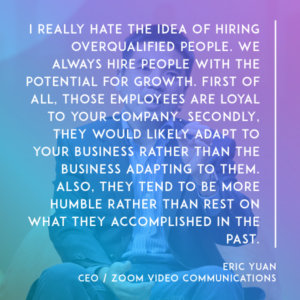
If you hire either managers or leaders, employees with potential for growth, first of all they’re loyal to your company. Secondly, they would likely adapt to your business rather than we adapt to them.
Also, they tend to be more humble rather than rest on what they accomplished in the past. Take our Head of Sales, Greg Holmes, for example. Before I hired him, many of my friends, they told me that, “You’ve got to hire a VP of Sales who already works for somebody else. You cannot hire just the direct level person.”
I said, “No,” because he has huge potential because he has a self learning mentality, self motivation mentality, also have a huge positive impact to other employees. Since then, almost for every position, we always hire for the potential with potential growth. We do not hire those people we think too qualified.
Mallun: I think you told me that your entire management team now is the original management team that you hired?
Eric: Yes, at least nobody left yet.
Mallun: [laughs]
Eric: I do not know.
Mallun: Or no one’s been replaced or topped, I guess. There’s a word that appears on this slide, as soon as it appears, that appears seven times on this slide. Can you guys figure out what that word is? It’s, happy, or happiness. Talk about being happy. In fact, it’s even, I think, three times on your LinkedIn title. Tell us about happiness.
 Eric: This is back to my personal story. Before I left Cisco to start a company, I always thought about what kind of company I wanted to build, I wanted to work for. I know to build a long term, successful, sustainable company, it’s a long journey. It’s really hard, not easy.
Eric: This is back to my personal story. Before I left Cisco to start a company, I always thought about what kind of company I wanted to build, I wanted to work for. I know to build a long term, successful, sustainable company, it’s a long journey. It’s really hard, not easy.
As you work on something very hard for many years, say you are successful, but guess what? You might celebrate it for one day. If you’re crazy enough, you might celebrate one week.
Looking back, many years of hard work, I think that’s the most important thing. Outcome, is more important. I think the process is more important, sorry, than the outcome. During that journey, if you do not build a company to deliver happiness to your employees, you feel like it’s kind of like a torture to your employees.

Many years of hard work…Employee every day, when they wake up, they really don’t want to go to office to work. I think that’s not a company I wanted to build. I really want to make sure every employee, many years after they retire when they look back, they can enjoy a sweet memory of those happy moments they shared at Zoom.
Mallun: That leads to the sixth learning which is, “Culture is number one.” I want to close with two questions actually. The first is, what’s the hardest thing you’ve had to go through in building Zoom?
Eric: Along the way, sometimes, you do not know what trigger that. Suddenly, you wake up in the night. You see so many problems down the road. Suddenly, you lost the confidence. However, the good news is, after you wake up the following day, you’re OK. That’s the hardest part.
Suddenly, at that moment, almost everything’s wrong. You sort of, “Do I work on the right thing? Are those customers happy? Are those employees happy or not…?” Suddenly, you lost your confidence during the night, sometimes.
Mallun: Is there a point when you thought, “Maybe we’re not going to make it”?
Eric: Yeah, it’s maybe once a year.
Mallun: Maybe once a year? [laughs]
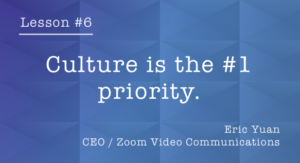
Eric: The good news is it’s not in the daytime, so no impact to our employees.
Mallun: Would you say it’s the first million dollars that’s the hardest for you? Or what was the hardest point for you?
Eric: The first million, for sure, is hardest part. We do not have a marketing team, just the engineers and a bunch of sales guys. We did it on purpose. We really want to test, “Is this product happy or not?” “Can we deliver happiness to our customer or not?”
We do not want to spend money on marketing side to generate leads. That’s why the first million is very hard. It’s more like to test water. If we know we can deliver first one million, we know we can deliver second, third…
Mallun: Jason talked a little bit about this in his opening. Given the recent executive order, what are your thoughts on the executive order and the limitation on immigration? You’re an immigrant, and you’re a founder. What can you share with us?
Eric: The way I look at it is, take the Silicon Valley for example, the reason why Silicon Valley is worldwide innovation center is because we embrace diversity. A lot of companies’ founders come from all kinds of background. That’s where the innovation come from.
If you lose that, down the road, I do not know what is going to happen for sure. I’m an immigrant. All the high tech companies, I think…it’s hard to say, but I really think that it’s not a smart decision.
Mallun: Great. Any final thoughts, Eric, you want to share?
Eric: I want to say a special thanks to Jason. When I stop by, I feel like for all the software service companies, this is our Super Bowl moment. We got to enjoy and have fun. Thank you.

